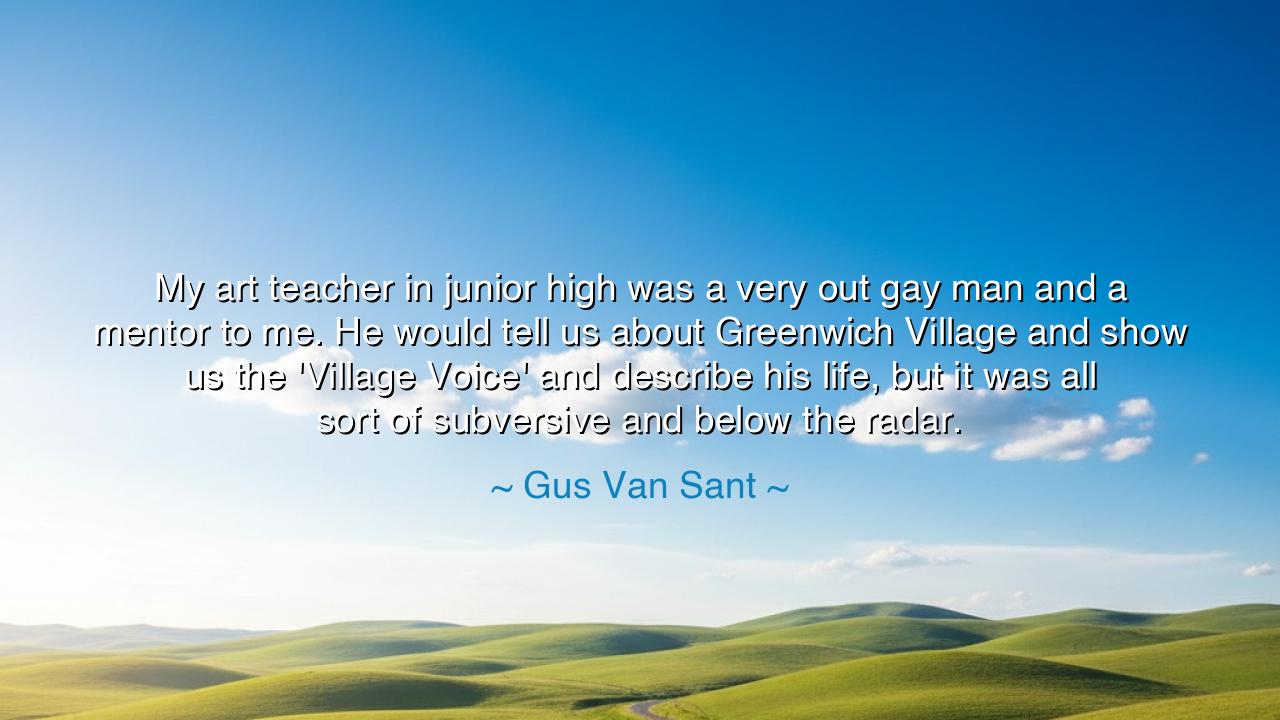
My art teacher in junior high was a very out gay man and a
My art teacher in junior high was a very out gay man and a mentor to me. He would tell us about Greenwich Village and show us the 'Village Voice' and describe his life, but it was all sort of subversive and below the radar.






Gus Van Sant, the visionary filmmaker, once recalled with reverence the hidden flame that guided him in youth: “My art teacher in junior high was a very out gay man and a mentor to me. He would tell us about Greenwich Village and show us the ‘Village Voice’ and describe his life, but it was all sort of subversive and below the radar.” In these words, he reveals the power of the teacher who dares to live authentically, even when the times demand silence, and the role of the mentor who plants in young hearts the seeds of courage, creativity, and truth.
The origin of this reflection is deeply tied to the cultural landscape of America in the mid-twentieth century. In those years, to be openly gay was to walk with risk, for prejudice was sharp and opportunity limited. Yet this art teacher stood unhidden before his students, not as an abstract lesson in tolerance, but as a living example of selfhood. His stories of Greenwich Village, of underground papers like the Village Voice, and of life lived outside the boundaries of convention were gifts of vision—windows into a world where expression and identity might thrive. To the young Van Sant, this was not just instruction in art, but initiation into a larger truth: that art and life are both acts of courage.
History itself testifies to the importance of such hidden mentors. In ages past, truths that could not yet be spoken openly were passed quietly from one generation to the next. Socrates, though condemned for corrupting the youth of Athens, whispered questions that awakened the minds of his disciples, shaping the course of philosophy. In more recent times, Harvey Milk stood as one of the first openly gay elected officials in America, giving public voice to what others had only dared to speak in private. In each case, the subversive truth began “below the radar,” nurtured by brave souls until it could break into the light.
The emotional power of Van Sant’s words lies in their recognition of the underground currents that shape culture. Not all revolutions begin with trumpets and banners; many begin in classrooms, in conversations, in the quiet sharing of forbidden books or whispered stories. The art teacher’s mentorship was not about rebellion for its own sake, but about showing his students that another world was possible—a world where identity was not hidden, where creativity was unbound, where life itself was art.
Yet his words also remind us of the cost of living authentically in a time of repression. To be “out” was to be vulnerable, and so the sharing had to be “below the radar.” This tension—between truth and safety, between visibility and concealment—is the crucible in which courage is forged. The teacher’s subversive honesty was a gift to his students, but also a risk to himself. Herein lies the heroism: to guide others into light even while walking under the shadow of danger.
The lesson for us is this: never underestimate the influence of authenticity. To live truthfully, even in small ways, may awaken courage in others. To mentor, to share one’s story, to show another world beyond the narrowness of the present—these acts may appear small, but they ripple outward across generations. The art teacher may have spoken of a distant Village, but in doing so, he helped cultivate an artist who would go on to shape the culture of the world through film.
Practically, this means that each of us must be willing to be mentors of truth, whether through art, story, or example. If you carry knowledge of a freer way of living, share it with those who still live in fear. If you have walked the hard road of authenticity, let others see the path. Live in such a way that even when your voice is “below the radar,” it still reaches the hearts of those who need it most.
Thus, Gus Van Sant’s remembrance is more than personal nostalgia—it is a parable of influence. One teacher, living authentically, gave courage to a young artist. One act of subversive honesty planted the seeds of cultural transformation. O listener, take this to heart: you too may be the one who lights another’s path, and though your flame may burn quietly, it may ignite a fire that illuminates the world.






AAdministratorAdministrator
Welcome, honored guests. Please leave a comment, we will respond soon